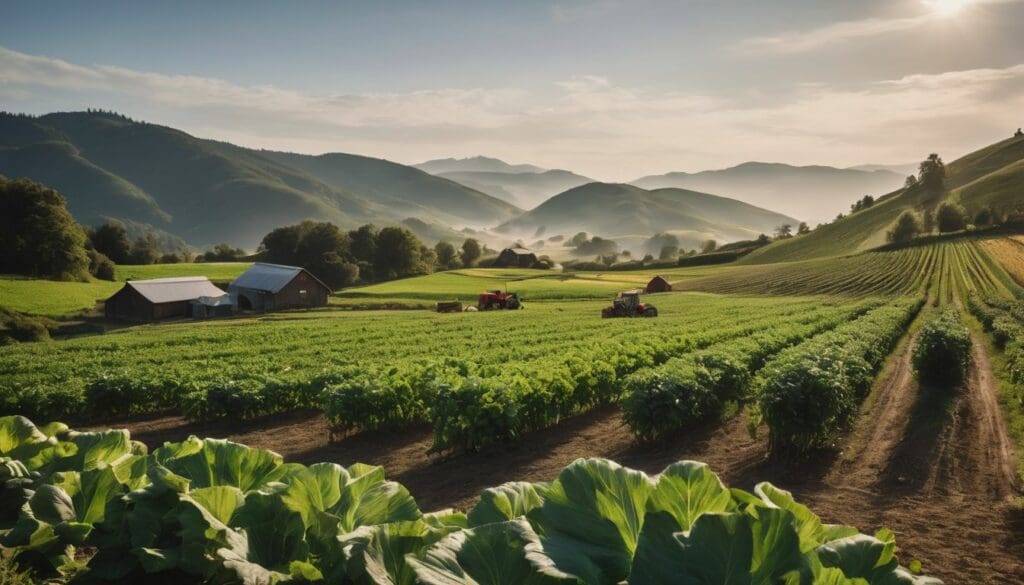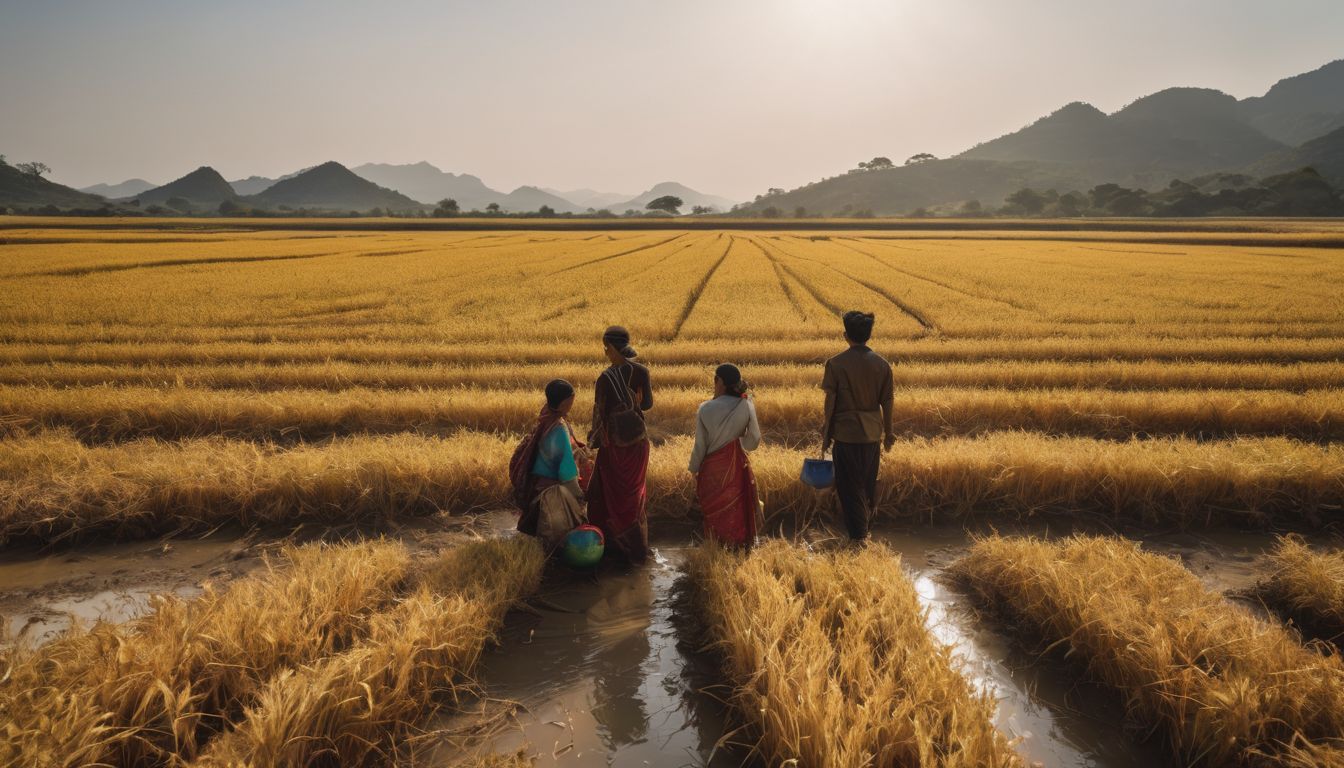As our planet heats up, growing food becomes a tougher challenge every day. By 2050, we may need to feed an extra two billion mouths amidst tricky climate shifts. This blog will give you easy-to-understand tips on farming that’s kind to our Earth and keeps us all fed.
Dive in for some ground-breaking ideas!
Key Takeaways
- Sustainable agriculture balances today’s food needs with future generations’ ability to meet theirs by maintaining soil health, conserving water and boosting biodiversity.
- Climate – Smart Agriculture, key for combating climate change, includes improving resource management, reducing carbon emissions and adapting farms to changing weather patterns.
- California sets an example with its sustainable farms featuring community-supported agriculture programmes that provide fresh produce directly to consumers while promoting eco-friendly farming methods.
- Small – scale farmers face increased challenges due to erratic weather caused by climate change; thus, they require support in accessing resources and markets for their products.
- Policies advancing climate – smart agriculture are essential; they incentivise sustainable practices that reduce greenhouse gas emissions and increase farm resilience amidst global warming.
Understanding Climate-Smart Agriculture
Climate-Smart Agriculture encompasses principles and practices that address food security and climate change, promoting sustainable farming techniques to mitigate the impact of global warming on agriculture.
By prioritising soil health, reducing carbon emissions, and efficient resource management, climate-smart agriculture seeks to create resilience in the face of changing weather patterns.
Definition and principles
Sustainable agriculture is the practice of farming that meets today’s food and textile needs without compromising the ability of future generations to meet theirs. It balances environmental health, economic profitability, and social equity to ensure a more secure future for everyone.
The principles at its core include maintaining healthy soil, using water wisely, reducing reliance on non-renewable energy sources, and enhancing biodiversity.
Farmers engage in conservation agriculture practices such as crop rotation and no-till farming to nurture soil health while conserving water. They integrate biological pest management instead of depending solely on chemicals.
These sustainable techniques lead to resilient farming practices capable of withstanding climate change pressures. This approach not only supports strong ecosystems but also provides safe, nutritious food supply chains for communities worldwide.
Addressing food security and climate change
Addressing food security and climate change involves implementing climate-smart agriculture practices to ensure reliable and sustainable food production. By prioritising soil conservation, water management, and climate-resilient crop varieties, farmers can adapt to changing weather patterns while reducing greenhouse gas emissions.
This approach not only secures food and feed supplies but also promotes sustainable land management for future generations.
Focusing on direct-to-consumer farming models also plays a key role in addressing food security challenges in the face of climate change. By creating shorter supply chains, these programmes mitigate the impact of extreme weather events on traditional distribution networks while promoting community-supported agriculture initiatives that build resilience within local communities.
The Impact of Climate Change on Agriculture and Food Security
Climate change is leading to changing weather patterns, which in turn are affecting the growth and yield of crops as well as livestock. This presents significant challenges for small-scale farmers who rely on consistent growing conditions for their livelihoods.
Changing weather patterns
Changing weather patterns impact agriculture and food security, posing challenges for farmers. Erratic rainfall affects crop growth and reduces yields. Extreme weather events like floods and droughts disrupt livestock rearing, leading to economic losses for small-scale farmers.
Adapting to these changes requires innovative climate-resilient agricultural techniques.
Farmers must adapt to changing weather patterns by implementing sustainable practices that promote resilience in the face of climate change. These include conservation agriculture methods, water management strategies, and diversifying crops to withstand various climatic conditions.
Effects on crops and livestock
Changing weather patterns due to climate change can lead to extreme events such as droughts, floods, and heatwaves. These conditions are harmful to crops, leading to reduced yields and compromised quality.
Livestock also suffer from increased heat stress and decreased availability of food and water, impacting their health and productivity.
Small-scale farmers face challenges in adapting their practices to the changing climate. Implementing resilient crop varieties and adopting sustainable livestock management techniques becomes crucial for maintaining agricultural productivity in a warming world.
Challenges for small-scale farmers
Small-scale farmers face significant challenges due to changing weather patterns and extreme climatic events. These impacts include erratic rainfall, prolonged droughts, and unpredictable changes in temperature, all of which affect the growth and yield of crops.
The increased frequency of pests and diseases also poses a threat to small-scale farming operations. Additionally, limited access to resources such as water, quality seeds, and modern farming techniques further compounds the struggles faced by these farmers in adapting to climate change.
Moreover, small-scale farmers often lack financial resilience to withstand crop failures or livestock losses caused by extreme weather events. They also encounter difficulties accessing markets for their products due to disruptions caused by climate-related factors.
Sustainable Agriculture Techniques for a Warming World
In response to the challenges of climate change, sustainable agriculture techniques such as conservation agriculture, reducing carbon emissions, and resource management are being implemented to ensure the resilience of our food systems.
These practices aim to mitigate the impact of rising temperatures and changing weather patterns on agricultural production.
Conservation agriculture
Conservation agriculture involves practices like minimal soil disturbance, crop rotation, and maintaining organic residues. These techniques help to improve soil health, reduce erosion, and enhance water retention.
By using cover crops and diverse plantings, conservation agriculture promotes biodiversity and reduces the need for chemical inputs. It also contributes to carbon sequestration in the soil, mitigating climate change impacts while ensuring sustainable food production.
Shifting to conservation agriculture can lead to increased productivity, improved resilience to climate extremes, and reduced environmental impact. This approach aligns with principles of agroecology and offers a viable solution for building climate-resilient agricultural systems that support both food security and environmental sustainability.
Reducing carbon emissions
Transitioning from conservation agriculture to reducing carbon emissions, sustainable farming practices play a crucial role in mitigating climate change. Implementing precision agriculture techniques, such as optimising fertiliser use and reducing tillage, can significantly decrease greenhouse gas emissions from agricultural activities.
Additionally, promoting agroforestry and integrating cover crops into cropping systems contribute to sequestering carbon in the soil while also enhancing its fertility. Embracing these methods not only diminishes carbon footprints but also fosters healthier ecosystems and resilient agricultural landscapes.
Applying renewable energy sources on farms further contributes to lowering carbon emissions associated with conventional farming practices. Harnessing solar power for irrigation and implementing wind turbines for electricity generation are viable options that facilitate a transition towards sustainable and low-carbon agricultural production.
Resource management
To ensure sustainable agriculture in a warming world, farmers must adopt resource management techniques. This involves using water efficiently, implementing soil conservation practices, and optimising energy use.
By managing resources wisely, farmers can reduce their environmental impact and increase the resilience of their farms to climate change. This includes adopting organic farming methods and regenerative agriculture practices to promote healthy soil and biodiversity.
Furthermore, resource management also involves promoting water conservation in agriculture by using efficient irrigation systems and reducing water wastage. Implementing these strategies can help mitigate the effects of climate change on agriculture while ensuring food security for future generations.
California’s Sustainable Farms: A Model for Agriculture in a Warming World
California’s sustainable farms, with their community-supported agriculture programs and direct access to consumers, serve as an exemplary model for agriculture in a warming world.
Discover how these innovative practices are paving the way for sustainable and climate-smart farming. Read on to learn more.
Community-supported agriculture programs
Community-supported agriculture programs enable consumers to directly support local farms by purchasing shares of the harvest. Participating in these initiatives provides individuals with fresh, locally grown produce while supporting sustainable farming practices.
Through community-supported agriculture programs, consumers have the opportunity to develop a deeper connection with their food sources and promote ecological farming methods that are better suited for a warming world.
By joining community-supported agriculture programmes, individuals can contribute to climate-resilient crops and embrace direct-to-consumer farming models. This approach empowers people to be actively engaged in sustainable agricultural practices and fosters a closer relationship between farmers and consumers.
Direct access to consumers
Transitioning from community-supported agriculture programs, a key aspect of sustainable farming in a warming world is the direct access to consumers. This approach allows farmers to bypass intermediaries and establish direct connections with individuals and local communities.
By selling directly to consumers through farmer’s markets, farm stands, or community-supported agriculture models, farmers can build relationships with their customers, share information about sustainable practices, and receive feedback on their products.
This direct interaction fosters transparency in food production and distribution. Consumers have the opportunity to learn about where their food comes from and how it was produced while supporting local agriculture.
The Role of Sustainable Agriculture in Combating Climate Change
Sustainable agriculture plays a key role in reducing greenhouse gas emissions, creating carbon sinks, and advocating for policies that support climate-smart farming practices. To learn more about how sustainable agriculture can combat climate change, read the full blog.
Reducing greenhouse gas emissions
Agriculture can actively reduce greenhouse gas emissions by adopting sustainable practices. Shifts to conservation agriculture and precision farming methods play pivotal roles in minimising carbon footprint.
Effective resource management also contributes significantly to lowering greenhouse gas emissions, promoting a healthier environment for future generations.
Implementing sustainable agricultural techniques alongside policy advancements is crucial for combating climate change. Creating carbon sinks through agroforestry and cover cropping aids in removing CO2 from the atmosphere.
Creating a carbon sink
After reducing greenhouse gas emissions, creating a carbon sink is essential for combating climate change. This involves practices such as afforestation and reforestation, which help absorb atmospheric carbon dioxide.
Additionally, promoting sustainable land management techniques like agroforestry and cover cropping can contribute to the sequestration of carbon in the soil, effectively mitigating the impacts of global warming.
Furthermore, integrating rotational grazing systems in livestock farming and restoring degraded ecosystems play vital roles in enhancing carbon storage. By harnessing these methods on agricultural lands globally, we can significantly offset greenhouse gas emissions and work towards building a more climate-resilient future for our planet.
Advancing policies for climate-smart agriculture
Policymakers worldwide are implementing regulations to promote climate-smart agriculture, supporting environmentally friendly farming practices. These policies aim to reduce greenhouse gas emissions, enhance resource efficiency, and boost the resilience of agricultural systems to climate change.
By incentivising sustainable techniques such as conservation agriculture and promoting the adoption of climate-resilient crops, these policies play a crucial role in mitigating the impact of climate change on food security and fostering environmental sustainability.
Governments are collaborating with agricultural organisations to develop strategies for adapting to changing climatic conditions while sustaining productivity. These efforts include creating financial incentives for farmers who implement carbon-reducing practices and integrating climate-resilient principles into national agricultural development plans.
Conclusion
In conclusion, sustainable agriculture offers crucial solutions in combating climate change. Farmers can adopt innovative techniques to increase resilience and reduce their carbon footprint.
Direct-to-consumer farming models like those in California showcase the potential for sustainable agriculture to thrive and make a significant impact. Policymakers must prioritise supportive measures for climate-smart agriculture to ensure a more secure future for food production.
FAQs
1. What is climate-smart agriculture?
Climate-smart agriculture means farming in ways that reduce its impact on the climate while increasing food and feed security in a warming world.
2. How does sustainable agriculture tackle climate change?
Sustainable agriculture uses methods that help adapt to and fight against climate change, like growing climate-resilient crops and practices that protect the environment.
3. Can farmers still provide enough food with direct-to-consumer farming when dealing with a changing climate?
Yes, direct-to-consumer farming can offer fresh produce directly from the farm to your table while using practices that help withstand changing climates.
4. Why is it important for crops to be climate-resilient?
Growing crops that are resilient to changes in weather patterns ensures we can continue to have secure sources of food as our global environment shifts due to warming temperatures.





